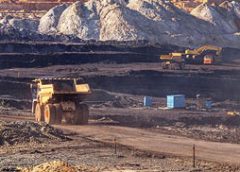According to ExxonMobil, the mining industry’s key risks include regulation, environmental concerns and operational challenges. Taking advantage of the latest advances in lubricant technology and analysis can smooth the ride. There are six areas of high risk for the sector, over the three broad categories of social license to operate, organizational and operational factors.
Smaller environmental footprint. One of the most significant risk areas for the mining sector is related to the environment. These risks include water contamination due to mining activities, and the transition to a low-carbon economy.
Choosing lubricants and greases with a long fluid life can help to reduce the amount of waste lubricant that a mine produces. Combined with robust procedures, this can reduce the risk of contamination through disposal. Swapping to a lubricant that has been formulated to increase energy efficiency can also be a step in the right direction.
Productivity optimization. Unplanned equipment downtime can raise the number of business interruptions for a mine and adversely affect productivity.
Lubricant analysis can help to reduce this risk by providing a proactive, predictive approach to maintenance. It works in a similar way to taking a blood sample in a medical checkup; monitoring the condition of your oils and greases is a health check for operations.
Reduced maintenance. Decreasing the amount of equipment maintenance and increasing equipment life can help to reduce risks to personnel safety and productivity.
One way of reducing the wear and tear on metal surfaces for heavy duty mining applications is using boundary lubricants such as graphite or molybdenum disulfide (moly), which ease friction under high loads without reacting with surface metal.
Gears and axles can also be subject to premature failures due to shocks and extreme loading. Lubricants formulated for these arduous conditions can help to keep these faults at bay for longer.
Improved safety. Health and safety are always risk factors for the mining industry. Many of the dangers associated with mining stem from interactions between people and machinery. Choosing a lubricant that reduces maintenance requirements and breakdowns will mean that employees spend less time in potentially hazardous situations. A lubricant with longer drain and lubrication intervals can also help to reduce risks to staff by lowering the number of times they need to carry out these maintenance tasks.
Lower costs. With tax and mining royalty increases on the horizon, cost savings delivered by using lubricants with the maximum life – which also reduce the costs of energy, maintenance and lost productivity – can make a difference to the industry’s bottom lines.
ExxonMobil, www.mobil.com/en/sap/business/mining

